Ultimate Guide to Cleaning Your Porcelain Sink
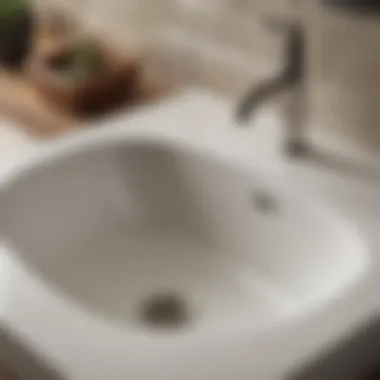
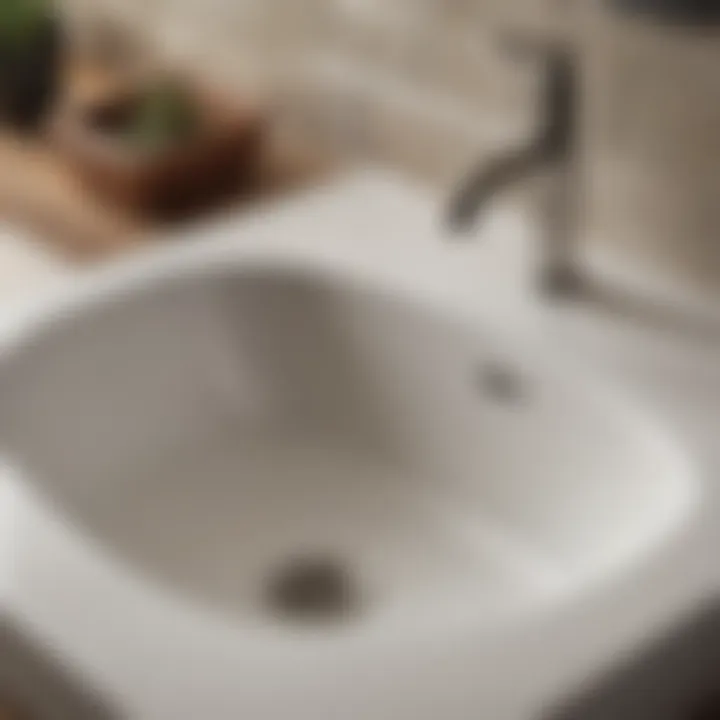
Intro
Cleaning a porcelain sink requires attention to detail and an understanding of the material. Porcelain, known for its durability and aesthetic appeal, can still be susceptible to stains and scratches. This guide aims to enhance the reader's knowledge on effectively cleaning and maintaining porcelain sinks.
Homeowners, interior design enthusiasts, and anyone keen on maintaining a clean space will benefit from practical advice and methods outlined in the following sections. With simple tools, appropriate cleaning agents, and an organized approach, restoring the luster of a porcelain sink is entirely achievable.
Key Insights and Trends
Understanding Porcelain
Porcelain sinks are favored for their smooth finish and resistance to heat. However, they require regular maintenance to avoid discoloration over time. There is a noticeable trend towards minimalistic designs, urging homeowners to keep their sinks pristine to enhance the overall aesthetic of their kitchens and bathrooms.
Common Stains and Their Causes
Understanding the types of stains that can affect a porcelain sink is crucial for effective cleaning:
- Water Spots: Often caused by hard water, leading to mineral deposits.
- Coffee Stains: Typically result from spills that are not wiped quickly.
- Rust: Can form from metal items left in the sink for extended periods.
Warnings about these stains can encourage timely cleaning, preserving the sink's appearance.
Practical Tips and How-To Guides
Step-by-Step Cleaning Instructions
Cleaning a porcelain sink can be straightforward if approached systematically. Here are steps to follow:
- Gather Your Materials: You will need baking soda, white vinegar, a soft sponge, microfiber cloth, and optional rubber gloves.
- Initial Rinse: Rinse the sink with warm water to remove loose debris.
- Apply Baking Soda: Sprinkle baking soda over the entire surface of the sink. This will help lift stains without scratching the surface.
- Add Vinegar: Spray white vinegar over the baking soda. The reaction between the two will help break down tough stains.
- Scrub Gently: Use a soft sponge to scrub the sink in a circular motion. Avoid abrasive scrubbers, as they can harm the porcelain finish.
- Rinse Thoroughly: Make sure to rinse away all cleaning agents with warm water, ensuring no residue is left behind.
- Drying the Sink: Use a microfiber cloth to dry the sink, preventing water spots.
Maintenance Tips
To keep your porcelain sink looking its best:
- Regularly rinse and dry after use.
- Avoid harsh chemicals that can damage the surface.
- Use mats or sinks guards to prevent scratches and chips.
Keeping your porcelain sink clean not only enhances its beauty but also prolongs its life, making maintenance worth the effort.
By incorporating these methods into your cleaning routines, you can maintain the allure of your porcelain sink while ensuring it remains a functional and stylish element in your home.
Intro to Porcelain Sinks
Porcelain sinks are much more than mere fixtures in our homes. They embody utility, aesthetics, and an enduring quality that many materials cannot match. Understanding the significance of porcelain as a material enhances our appreciation for these sinks. With correct maintenance, they sustain their beautiful appearance and functionality for years. This section explores the importance of porcelain sinks, their unique properties, and why homeowners and design enthusiasts favor them.
Understanding Porcelain as a Material
Porcelain is a ceramic material that is fired at high temperatures, resulting in a dense, strong product. Its composition typically includes kaolin, feldspar, and quartz. The high firing temperature not only contributes to its strength but also to its minimal porosity. This intrinsic quality makes porcelain resistant to staining, odors, and bacteria. However, it is essential to note that while porcelain sinks are durable, they can be susceptible to chips and cracks if treated roughly.
The finish on porcelain offers a smooth surface that is easy to clean. This maintainability is a critical aspect of why porcelain is preferred in kitchens and bathrooms. Additionally, the glossy surface reflects light well, enhancing the overall elegance of space. Porcelain sinks can be found in various colors and styles, allowing homeowners to choose designs that complement their interior aesthetics.
Common Uses for Porcelain Sinks
Porcelain sinks find applications in diverse areas, from domestic environments to professional settings. Here are some common uses:
- Kitchen Sinks: Their durability and ease of cleaning make them an ideal choice for kitchen environments where spills and stains are common.
- Bathroom Sinks: In bathrooms, porcelain sinks offer a classic look and seamless integration into various decor styles.
- Utility Sinks: These sinks are often utilized in laundry rooms due to their robust nature, designed to handle heavy-duty cleaning tasks.
- Commercial Spaces: Restaurants and cafes opt for porcelain sinks for their high resistance to stains and ease of sanitization, crucial in maintaining hygiene standards.
Porcelain sinks not only provide functionality but also contribute to the overall design of a space. Their timeless quality appeals to those desiring practicality without sacrificing style.
Preparing for Cleaning
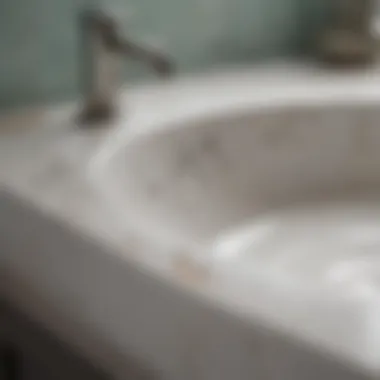
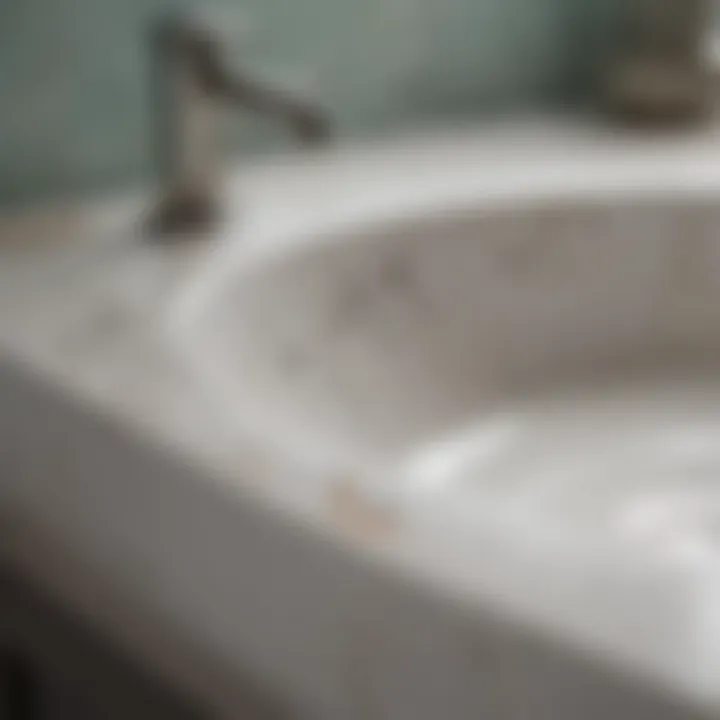
Cleaning a porcelain sink requires preparation to ensure the best results and to protect the sink's surface. Preparing effectively can prevent damage and increase efficiency. By assessing the condition of your sink and gathering the right supplies, you set the stage for a successful cleaning experience. This step is crucial as it dictates the methods you will use and the effectiveness of your cleaning efforts.
Gathering Necessary Cleaning Supplies
Before beginning the cleaning process, it is essential to gather all necessary supplies to streamline your efforts. Having everything on hand saves time and reduces frustration. The following are common supplies you may need:
- Soft cloths or sponges: Avoid harsh scrubbers as they can scratch the surface of the porcelain.
- Mild dish soap: A simple yet effective cleaner that is gentle on the material.
- Baking soda: This works well as a gentle abrasive, helping to lift stains.
- White vinegar: Useful for cutting grease and eliminating odors, and it can help remove discoloration.
- Commercial cleaners designed for porcelain: While optional, some products are specifically formulated to clean porcelain.
With these supplies ready, you can proceed without unnecessary interruptions. A well-prepared workspace will make the process of cleaning smoother and more manageable.
Assessing Your Sink's Condition
Before applying any cleaners, assessing the condition of your porcelain sink is vital. This step focuses on identifying any specific issues that need addressing. Start by examining the sink for visible stains, chips, or cracks.
- Stains: Check for different types of stains that may require different cleaning methods. Dull spots or yellowing might indicate hard water deposits or soap scum.
- Chips and Cracks: Look closely for chips or cracks. These may need special treatment to prevent further damage during cleaning.
Understanding the condition of your sink will inform your cleaning strategy, ensuring you choose the appropriate techniques and products. If chips or cracks are severe, opting for repair may be necessary before diving into the cleaning process.
Cleaning Techniques
Cleaning techniques play a pivotal role in maintaining the aesthetic and functional quality of a porcelain sink. Not only do they ensure the sink appears visually appealing, but they also enhance its longevity. A porcelain sink, known for its durability and elegant finish, requires specific cleaning approaches to avoid damage. The right techniques can eliminate stains, prevent scratches, and maintain the sink's glossy surface. This section highlights essential cleaning techniques that cater to different situations, from regular maintenance to aggressive stain removal.
Basic Cleaning Procedure
The basic cleaning procedure for a porcelain sink involves minimal effort but can yield significant results. Regular and simple cleaning can prevent buildup and staining over time. To begin, gather the necessary supplies: a soft sponge or cloth, liquid dish soap, and warm water.
- Preparation: Begin by rinsing the sink with warm water. This step helps to loosen any debris or soap residue.
- Soaping: Apply a few drops of liquid dish soap directly onto the sponge or the sink surface.
- Wiping: Gently scrub the sink with the sponge in circular motions. Focus on any areas with soap scum or hard water deposits.
- Rinsing: Once satisfied with the clean, rinse the sink thoroughly with warm water to remove all soap remnants.
- Drying: Finally, use a soft towel to dry the sink surface. This step reduces water spots and enhances shine.
This procedure should be incorporated as a routine cleaning habit for optimal sink maintenance.
Dealing with Stubborn Stains
Stubborn stains can occur even with regular cleaning. Addressing these requires a more targeted approach. Here are several methods to combat persistent stains:
- Baking Soda Paste: Mix baking soda with water to form a paste. Apply it to the stain and let it sit for 10-15 minutes. Scrub it gently with a sponge and rinse with water.
- Vinegar Solution: Spray white vinegar on the stained area, letting it sit for about five minutes. This acidic solution can help break down tough stains. Wipe with a cloth afterward.
- Hydrogen Peroxide: For stains like rust or inking, apply hydrogen peroxide directly to the affected area. Let it sit for several minutes before rinsing off thoroughly.
Be cautious while using these products. Some materials can react with porcelain, leading to damage. Always test in a small, inconspicuous area first.
Using Safe Abrasives
Sometimes, a more abrasive approach is necessary, especially for removing ingrained dirt or scratches. However, using abrasives safely is paramount to avoid harming the porcelain. Here are some options:
- Baking Soda: This common household item serves as a mild abrasive and is safe for porcelain. It can be used in a paste form, as discussed earlier, or as a scrub when dry.
- Non-scratch pads: Look for non-scratch scrub sponges designed specifically for sensitive surfaces.
- Commercially available cleaners: Products like Bar Keepers Friend, which are specifically formulated for porcelain, can effectively clean without scratching.
Always follow the manufacturer’s guidelines for any cleaning product. Using the right abrasive at the right intensity can restore the surface's appearance without causing harm.
"Using the right cleaning techniques not only improves appearance but also extends the life of your porcelain sink."
Cleaning Agents for Porcelain Sinks
Choosing the right cleaning agents for porcelain sinks is essential. The cleaning agents not only affect how well you can remove stains and buildup but also impact the durability of the sink. Porcelain is a fragile material that can be damaged by harsh chemicals or abrasive agents. Therefore, understanding the types of cleaners available is crucial.
A well-selected cleaning agent can bring back the shine of your sink without risking any long-term damage. Knowing what to use not only improves the appearance of your sink but also helps maintain its condition longer. Here are important considerations for selecting cleaning agents for your porcelain sink:
- Effectiveness: The chosen cleaner must effectively remove dirt and stains.
- Material Safety: Ensure that the cleaner will not scratch or damage the porcelain surface.
- Environmental Impact: With growing concerns about chemical usage, choosing eco-friendly options can be beneficial for both health and the environment.
"A clean sink not only enhances your kitchen or bathroom appeal but also extends the life of the porcelain material."

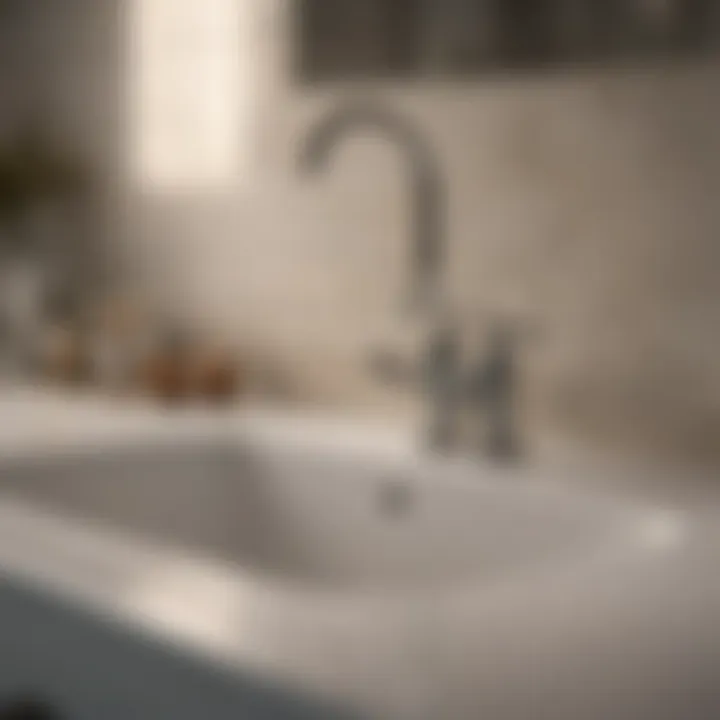
Commercial Cleaners
Commercial cleaners are specifically formulated products designed for various cleaning tasks. In the context of porcelain sinks, they can be powerful solutions for common stains. When choosing a commercial cleaner for your porcelain sink, look for products that are marked safe for porcelain.
Some advantages of commercial cleaners include:
- Ease of Use: They are often ready for use and require little preparation.
- Specialized Formulas: Many products target specific stains whether they are mineral deposits, food residues, or soap scum.
- Quick Results: Many commercial cleaners can remove stains quickly, saving you time.
However, be cautious. Some cleaners may contain harsh chemicals. It is always wise to read the ingredient labels and ensure that they will not harm your sink. Look for brands like Soft Scrub or Weiman, which often have options focused on porcelain.
Homemade Cleaning Solutions
Homemade cleaning solutions provide an alternative to commercial products. Many homeowners prefer them for their effectiveness and safety. Making your own solution can reduce chemical exposure while providing efficient cleaning results.
A few popular homemade solutions include:
- Baking Soda and Vinegar: This combination works well for lifting stains and mineral deposits. Baking soda acts as a gentle abrasive, while vinegar can break down grime.
- Lemon Juice and Baking Soda: The acidity of lemon juice helps tackle stains, and baking soda adds scrubbing power.
- Dish Soap and Warm Water: This universal solution is effective for regular cleaning, helping to remove light dirt and soap scum.
To create a simple baking soda paste, mix one cup of baking soda with a few tablespoons of water until it forms a paste. Apply it to the stained areas, let it sit for a few minutes, and then scrub gently.
Utilizing these solutions can be effective in maintaining the porcelain finish of your sink. They are generally safe and cost-effective options.
Post-Cleaning Maintenance
Post-cleaning maintenance is an essential aspect of caring for a porcelain sink. It not only helps maintain the visual appeal but also extends the lifespan of the sink. Proper maintenance between cleanings ensures that the natural shine of the porcelain is preserved, while preventing damage such as stains or scratches from becoming permanent. Therefore, it is crucial to incorporate effective maintenance techniques into your regular cleaning routine.
Drying Techniques
Effective drying techniques after cleaning can significantly reduce water spots and mineral deposits on your sink. Here are some methods you can employ:
- Microfiber Cloth: Using a microfiber cloth is ideal for drying your porcelain sink. Its fine fibers absorb moisture effectively and are gentle on the surface.
- Soft Towels: A soft cotton towel can also do the job. Ensure that the towel is clean to avoid transferring any dirt or debris.
- Air Drying: If you prefer a hands-off approach, allowing the sink to air dry is another option. However, be cautious as this can lead to water marks, especially in hard water areas.
After drying, always check for any stubborn spots or streaks and address them with a mild cleaner or a vinegar solution if needed. This step is essential in keeping the sink looking pristine throughout the week.
Protective Coating Options
Applying a protective coating on your porcelain sink can be beneficial in maintaining its luster and preventing future stains. Here are a few protective options:
- Sealants: There are sealants specifically designed for porcelain that can be applied after thorough cleaning. These products form a protective barrier that repels water and grime.
- Car Wax: Surprisingly, applying a coat of car wax can also yield good results. It provides a shiny finish while offering some level of protection against stains.
- Homemade Alternative: You can create a simple protective solution using a mix of olive oil and vinegar. Apply it to the sink and buff it to shine lightly. This can help maintain glossiness while offering basic protection.
By integrating these protective measures into your cleaning regimen, you can effectively reduce maintenance frequency and keep your sink looking new for years to come.
"Regular maintenance can transform the way you view your porcelain sink, ensuring it remains a centerpiece of your kitchen or bathroom."
Adopting these post-cleaning practices will ensure that your porcelain sink remains not just clean but also in optimal condition, serving as a testament to careful homeownership.
Common Issues and Solutions
Cleaning a porcelain sink can sometimes be challenging. Homeowners often encounter various problems that can affect the sink's appearance and functionality. Addressing these common issues is vital for maintaining a sink that looks good and lasts longer. This section will explore the typical problems that arise with porcelain sinks, providing practical solutions for each. By understanding these issues, you can take appropriate measures to keep your sink in optimal condition.
Chips and Cracks in Porcelain
Chips and cracks can occur in porcelain sinks due to impacts from heavy objects or drastic temperature changes. When a sink experiences a chip, it may not only look unattractive but also become a breeding ground for bacteria. Moreover, cracks can expand over time, leading to more serious damage.
Repairing small chips is possible with porcelain repair kits available at most home improvement stores. Here are steps to handle this issue:
- Clean the area: Remove any debris or grime around the chip.
- Apply the epoxy: Choose an epoxy designed for porcelain. Apply it carefully, following the product instructions.
- Smooth the surface: Once dry, sand the area to make it flush with the surrounding surface.
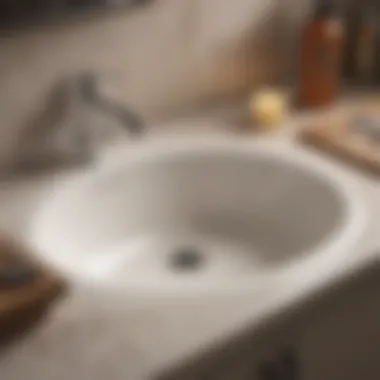
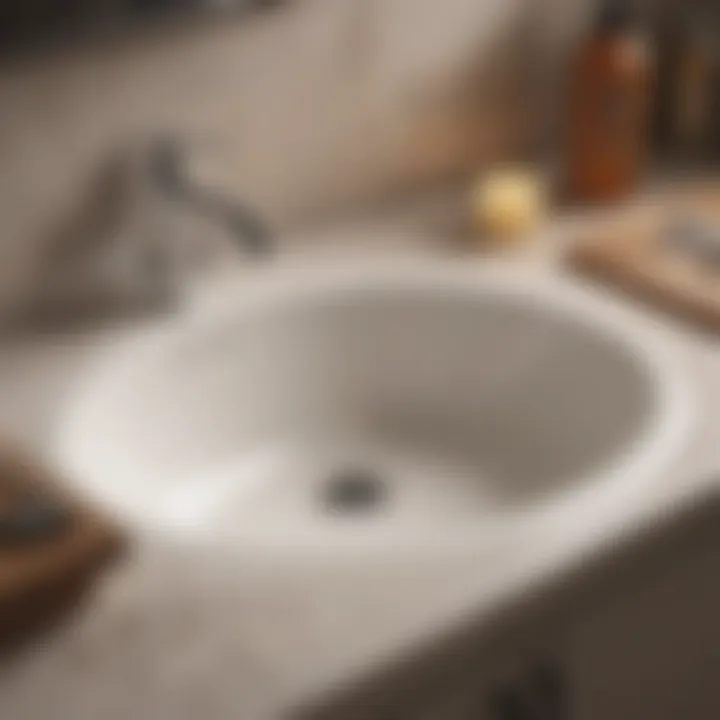
For larger cracks, it may be wiser to consult a professional. Ignoring the issue can lead to leaks and further damage, which can be costly to repair.
Yellowing and Discoloration
Over time, porcelain sinks can develop a yellowish tint or discoloration. This change in color is often caused by the accumulation of oils, stains from food, or exposure to harsh cleaning agents.
To restore the sink’s bright white finish, consider the following options:
- Baking soda paste: Mix baking soda with water to create a paste. Apply it to the stained areas and let it sit for at least 15 minutes before scrubbing gently with a soft cloth.
- Hydrogen peroxide: Use hydrogen peroxide to lift stubborn stains. Apply it directly to the discolored areas and let it sit for about an hour.
- Vinegar solution: A solution made from equal parts vinegar and water can help remove light discolorations. Apply it then rinse thoroughly.
Regular cleaning can prevent discoloration and keep your sink looking fresh. Using gentle cleaning methods is key to avoiding further damage to the porcelain's surface.
Hard Water Deposits
Hard water deposits, also known as limescale, can accumulate in fixtures, especially in areas with hard water. Over time, these deposits create unsightly spots and can cause water flow issues.
To effectively remove these deposits, you can:
- Use vinegar: Soak a cloth with vinegar and wrap it around the affected areas. Allow it to sit for several hours before scrubbing with a non-abrasive sponge.
- Buy a commercial descaler: Many products are specifically designed to break down hard water deposits. Follow the instructions carefully for the best results.
- Preventive measures: Installing a water softener can reduce hard water issues in the long run. Regular cleaning can also help in keeping the deposits from returning.
Consider maintaining a regular cleaning schedule to handle these common porcelain sink issues before they escalate into larger problems.
Environmental Considerations
In today’s world, being conscious of our environmental impact is paramount, especially in home maintenance practices. Cleaning a porcelain sink is no exception. The choices we make regarding cleaning agents and methods can have lasting effects on the ecosystem. This section aims to delve into why these environmental considerations are important in the context of cleaning porcelain sinks, highlighting specific elements and the benefits derived from them.
Choosing Eco-Friendly Products
When choosing cleaning products for porcelain sinks, eco-friendliness should be at the forefront. Many commercial cleaners may contain harsh chemicals that not only damage the sink's finish but also harm aquatic life when they enter water systems.
Opt for eco-friendly cleaners that utilize natural ingredients. These products are often biodegradable and free from corrosive chemicals. Look for options labeled as non-toxic or containing plant-based components. Some effective eco-friendly choices include:
- Vinegar: A powerful natural cleaner, vinegar can effectively cut through grime without causing any environmental harm.
- Baking Soda: This is excellent for tackling stubborn stains and is safe for the environment.
- Lemon Juice: With its natural acidity, lemon juice can help brighten and clean, while leaving a pleasant scent.
By opting for these natural alternatives, you reduce the harmful substances that enter the water supply, thus preserving local waterways and promoting a healthier ecosystem.
Minimizing Water Waste
Water conservation is a crucial aspect of environmental stewardship. When cleaning a porcelain sink, it is essential to adopt practices that minimize water usage.
Here are a few strategies to consider:
- Use a Spray Bottle: Instead of running water continuously, fill a spray bottle with cleaning solutions. This allows for controlled application without excessive waste.
- Wipe First: Before rinsing, wipe down the sink with a cloth. This reduces the need for additional water to flush away dirt and grime.
- Limit Rinse Time: When rinsing, turn the water to a low flow setting. This approach can drastically cut down the total amount of water used during the entire cleaning process.
"Conserving water when cleaning not only benefits the environment but can also lead to lower utility bills."
Integrating these water-saving techniques into your cleaning routine promotes responsible usage of one of our most precious resources. By being mindful of both the products used and the water consumed, we can effectively clean our porcelain sinks while protecting our planet.
Finale
Cleaning a porcelain sink is more than just a routine task; it is an investment in the aesthetic and functional quality of your home. At the conclusion of this guide, it is vital to underscore key elements for maintaining the integrity of your porcelain sink. Effective cleaning strategies contribute to the sink's appeal while preventing long-term damage.
Recap of Effective Cleaning Strategies
In summary, successful care for a porcelain sink involves:
- Regular Cleaning: Establish a cleaning schedule to remove buildup and prevent stains.
- Use of Appropriate Cleaners: Different types of stains require specific cleaning agents, whether commercial or homemade solutions. Be mindful about the abrasiveness of each cleaner to avoid damaging the surface.
- Addressing Stains Promptly: Prompt action on stains, particularly food or mineral deposits, leads to better cleaning outcomes.
- Employing Safe Abrasives: While scrubbing may be necessary, it's crucial to choose non-scratch pads to preserve the sink's finish.
- Drying the Sink: Proper drying techniques, such as using a soft cloth after cleaning, prevent water spots and mineral buildup.
Encouragement for Regular Maintenance
Regular maintenance is essential for prolonging the life and beauty of your porcelain sink. Tasks such as daily wiping, immediate attention to spills, and periodic deep cleaning will enhance the sink's longevity.
Keeping your sink in top condition reflects the overall maintenance of your home. Consider simple practices, like using a mild soap and soft cloth daily, to ensure the sink stays gleaming. Maintaining a clean porcelain sink not only uplifts the kitchen or bathroom aesthetics but also fosters a hygienic environment. By integrating these maintenance habits, homeowners can minimize the need for extensive restoration efforts, ensuring that their porcelain sink remains a striking centerpiece in their home for years.
"An ounce of prevention is worth a pound of cure."



